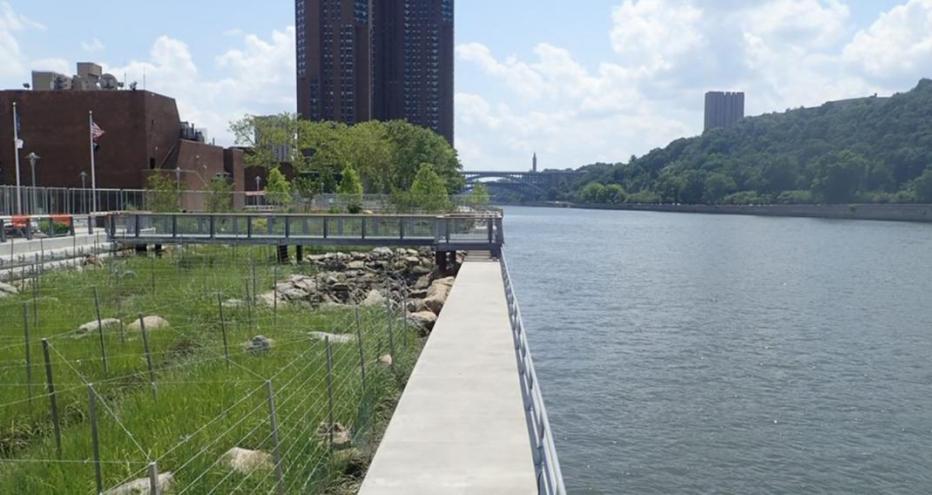
Located along the Harlem River, the already heavily-deteriorated 2,200-foot long steel bulkhead that protects a large residential complex, two near-by schools and important assets such as the Metro-North Railroad line and a power transmission line sustained further damage during the storm, making its replacement even more critical. In addition, a 1,300-foot long section of shoreline to the north of the bulkhead was also in need of stabilization as part of the revitalization of the upland sports fields and parkland.
-
9 K
square feet of inter-tidal parkland created
-
1 st
Roberto Clemente is the first Latino-American inducted into the Baseball Hall of Fame
-
1.3 M
visitors a year come to Roberto Clemente State Park
-
25
acres in size
“Working with the NY State Parks Department to re-build the Roberto Clemente State Park was a great experience. Our team built a resilient design that protects the park while offering educational components such as the tidal pools. As an engineer, it feels incredible to see the transformation from calculations on our desktops to a park being enjoyed by the community. The park highlights resiliency and green infrastructure and will continue to be a tribute to Roberto Clemente for years to come.”
In Detail: Roberto Clemente State Park Bulkhead Replacement and North Shoreline Rehabilitation
Bulkhead Replacement
The park’s shoreline consists of a steel sheet pile bulkhead at the southern end and an un-engineered riprap revetment at the northern end. As part of a team, Jacobs performed above water and underwater inspections of the shoreline in 2006 and developed various conceptual designs for the rehabilitation of the severely deteriorated bulkhead in 2007.
In 2010, a Jacobs-led team was awarded the final design of the new bulkhead and shoreline stabilization, based on the concepts developed in the earlier stage. The final adopted plan included the reconstruction of a new 2,200-foot-long steel sheet pile bulkhead immediately outboard of the existing structure and tidal pool with pedestrian walkways.
Reconstruction of the existing bulkhead required the removal of the existing railing, concrete cap, portions of the concrete esplanade and a portion of the steel sheet piles along the entire length of the existing bulkhead. Jacobs oversaw the implementation of a comprehensive geotechnical investigation program for the design of the replacement bulkhead.
The reconstructed bulkhead utilized both anchored and cantilevered steel sheet pile bulkheads. For the anchored bulkhead, soil anchors were used to minimize disruption to the existing upland structures and esplanade reconstruction. A cantilevered bulkhead comprising a combi-wall system was adopted in the section of the esplanade where a tidal pool was incorporated into the plaza. Specially designed openings were provided in the bulkhead wall to allow water from the Harlem River to circulate within the tidal pool for the creation of a tidal habitat. A steel walkway and get-down structure within the tidal pool allow the public to experience the tidal pool habitat up close.
In addition to the coastal, geotechnical and structural engineering design services for the bulkhead, Jacobs also obtained all required environmental permits (including the design of any required mitigation works) and supported NYS Office of Parks, Recreation, and Historic Preservation through the construction process with additional design and engineering services. Reconstruction and repairs of the upland esplanade utilities, structures, and amenities were also performed by the Jacobs-led team.
North Shoreline Rehabilitation
In 2016, Jacob was part of the team awarded the final design for the rehabilitation of approximately 1,300 feet of the existing shoreline (North Shoreline) to the north of the recently reconstructed bulkhead, the rebuilding of the existing upland recreational fields, and enhancements to the park facilities. Jacobs’ role was marine engineering design services that included developing and overseeing a geotechnical investigation for the shoreline protection, the detailed design of the shoreline rehabilitation, and providing in-water work permitting support to the team.
The shoreline rehabilitation plan included the removal of existing debris along the eroded shoreline, installation of a new revetment to stabilize and protect the existing shoreline, installation of a living shoreline at the southern end of the site to create a marine and wildlife habitat, the addition of new drainage outfalls, and the design of a new floating dock for kayaks and crew shells.
To minimize the impact on the marine environment, the footprint of the proposed revetment was carefully coordinated with the proposed upland work to maintain a net removal of material from the waterway. In addition, the existing rocks that were unearthed during the previous phase of bulkhead reconstruction to the south were inspected and carefully selected to reuse in the proposed revetment. The updated park along the North Shoreline features new multi-purpose recreational fields, plantings along the shoreline, pathways and rolling hills.
Jacobs also provided engineering support during construction.














































